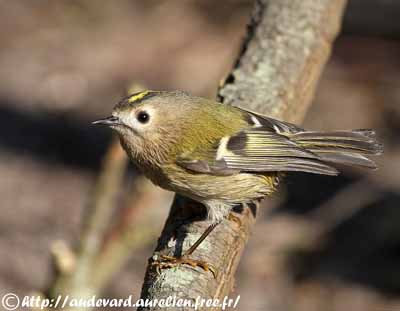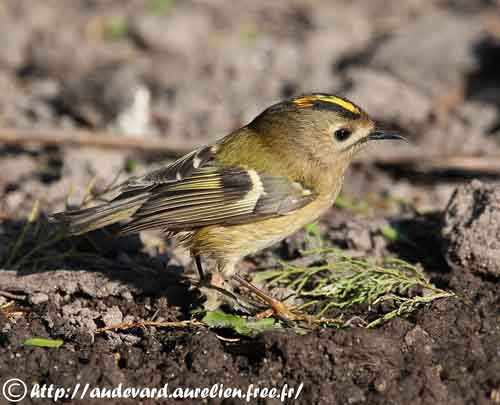
Goldcrest
Regulus regulus
Passeriforme Order – Regulidae Family
BIOMETRICS:
L : 9 cm
Poids : 5-7 gr
DESCRIPTION:
Goldcrest is one of the smallest birds living in Europe. Upperparts are olive green. The rounded and very broad wings show two white wing bars and dark flight feathers. Underparts are buff white.
PROTECTION / THREATS / STATUS:
Goldcrest is very vulnerable to hard winters, and numerous birds die if the cold weather lasts too long time. But this species reaches a very good reproduction and populations increase again after winter decline.
Fr: Roitelet huppé
All : Wintergoldhähnchen
Esp : Reyezuelo Sencillo
Ital : Regolo eurasiatico
Nd : Goudhaantje
Russe : Желтоголовый королек
Sd: Kungsfågel
Photographers :
Aurélien Audevard
OUESSANT DIGISCOPING
Didier Buysse
Vision d’Oiseaux
Steve Garvie
RAINBIRDER Photo galleries
Jean Michel Peers
JMPN PHOTOGRAPHIE
Jean Marc Rabby
Des Ailes et des Plumes
Nicole Bouglouan
PHOTOGRAPHIC RAMBLE
Text by Nicole Bouglouan
Sources :
HANDBOOK OF THE BIRDS OF THE WORLD Vol 11 by Josep del Hoyo, Andrew Elliott and David Christie - Lynx Edicions - ISBN: 849655306X
THE HANDBOOK OF BIRD IDENTIFICATION FOR EUROPE AND THE WESTERN PALEARCTIC by Mark Beaman, Steve Madge - C.Helm - ISBN: 0713639601
THE COMPLETE BOOK OF BRITISH BIRDS – Written by “Royal Society for the Protection of Birds” experts - Préface de Magnus Magnusson - Michael Cady- Rob Hume Editors - ISBN: 0749509112
BIRDS OF THE MIDDLE EAST by R.F. Porter, S. Christensen, P Schiermacker-Ansen C.Helm - ISBN: 0713670169
Birds of Britain - The Web Magazine for Birdwatchers

It has pale face with orange crown in male and yellow crest in female. Orange and yellow are bordered with black in both sexes. These feathers form a short crest when the bird is excited or alarmed.
Eyes are dark, surrounded by white short feathers. The thin, pointed bill is black. Legs and feet are pale brown. Goldcrest has strong toes to grasp the branches in upside-down posture.
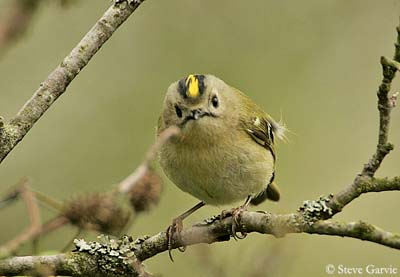
Juvenile is similar to adult, but it lacks the head markings until the first autumn.
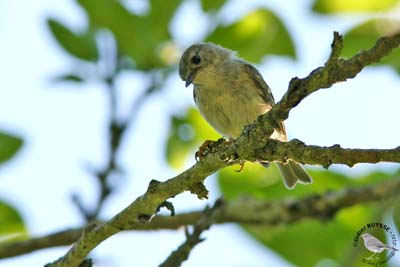
We find two subspecies in Canary Islands. There are two distinct populations living in different islands:
Tenerife Goldcrest, Regulus r. teneriffae, is resident in Tenerife and La Gomera. This one is slightly smaller, but its bill is longer. Its plumage is brighter and the black crown stripes meet on forehead. (Displayed)
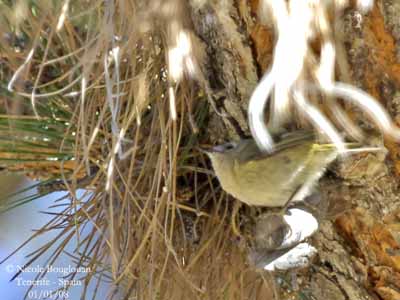
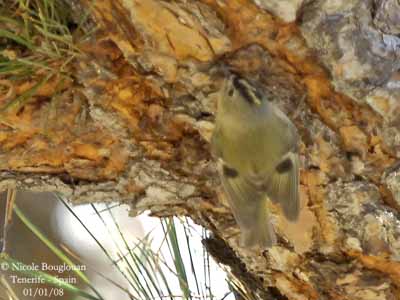
Western Canary Island Goldcrest, Regulus r. ellenthalerae, lives in La Palma and Hierro.
We can find 14 subspecies which differ in plumage coloration and size.
VOICE: SONS PAR XENO-CANTO
Song and calls are very high-pitched, and the frequency may be virtually inaudible to some ears.
Goldcrest’s call is quiet and repeated “zee-zee-zee”, and stronger when on move “zit-zit-zit”.
The song is a high-pitched, thin and penetrating jingling “ze-zezeezee”-ze-zezeezee…” ending in some flourishes “zi-zi-zip” or “zi-zi zveet”.
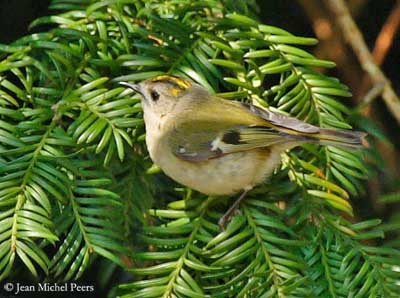
HABITAT:
Goldcrest breeds in conifer and mixed woodlands, in large gardens and parks with conifers. Outside breeding season, it also lives in scrub and in deciduous trees.
RANGE:
Goldcrest breeds in temperate Europe and Asia. Partially migratory, the northern populations winter in the south of the breeding range.
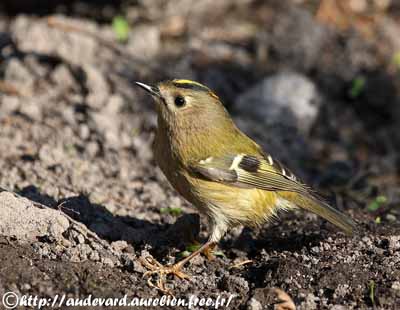
BEHAVIOUR:
Goldcrest is a tiny and hyperactive bird. It is always fluttering and flitting through outer canopy, always moving to lower perches, changing of trees and bushes, with wings and tail flicking. When hidden in dense conifers, it gives away its presence thanks to its high-pitched call.
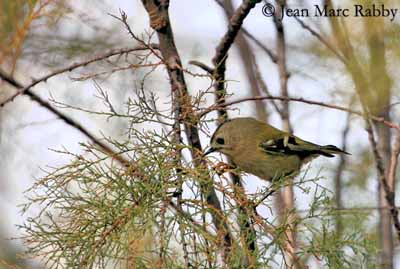
It forages into foliage and probes into bark crevices with its pointed bill. It often hangs upside down or flitters to catch insects on the underside of leaves.
Goldcrests are often seen in small groups.
Northern birds move to south in winter, and may travel about 1000 km in a week. During winter, Goldcrests have an erratic behaviour, joining groups of sedentary birds of the same species. They fly long distances, but bad weather can stop their migration.
They are vulnerable during hard winters, and their numbers may decline of 75 to 80 %. But the populations increase if winters are temperate. During hard winters, these birds feed all day round, and roost together at night in dense vegetation, very close to each other.
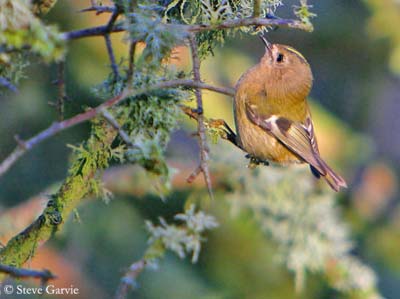
Courtship displays start in late April or early May. The sedentary males sing to establish their territories and attract some females. The male displays its bright orange crest in front of its mate. Breeding pairs are very active and to build the nest takes from a few days to three weeks.
Higher conifers include several breeding pairs at each level of the trees. Several territories can occur in the same tree.
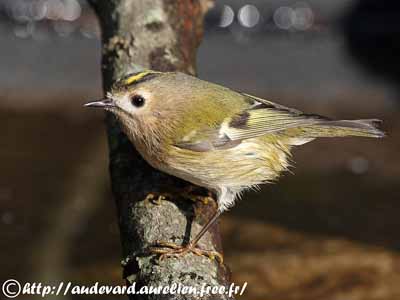
FLIGHT:
Goldcrest may fly easily among dense vegetation and flutter to find its preys with its broad rounded wings. It rarely flies more of some tens of metres, except during migrations. This species is able to fly up to 1000 km within a week. When flying long distances, the flight is undulating.
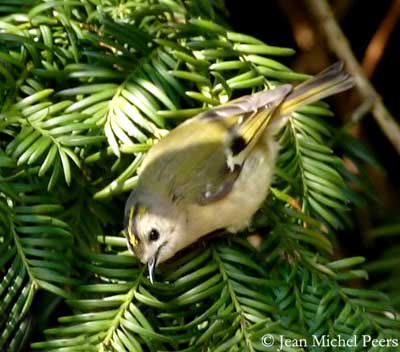
REPRODUCTION:
Goldcrest’s nest is hammock-shaped, built by both male and female, but mainly by male. This nest is built on the outer branches in conifer. This action may last almost three weeks. Nest includes three distinct parts. Outerpart is made with mosses and lichens, woven with spider webs, and well caught to the branches. Median part of the nest is made with mosses, and inner part is lined with hair and feathers. The nest is almost spherical with a narrow entrance close to the top. It is located relatively high in trees, up to 15 metres.
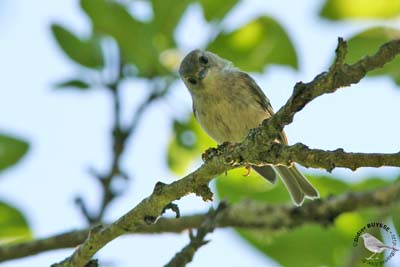
Female lays 9 to 12 smooth and pale eggs with a few markings, one egg per day. Incubation lasts about 16 days, and starts before all eggs are laid. Female incubates, broods and cares the young for the first seven days. Male feeds female at nest and both adults feeds the young which fledge at about 17 to 22 days.
Parents start to prepare the next clutch while they are still feeding the first. Female may lay its second brood, even with the first still at nest.
This species may produce two broods, about 20 young at least per year!
They breed when food resources are abundant and days long enough.
DIET:
Goldcrest feeds on small insects and spiders found in trees. During winter, it feeds on seeds and insects on the ground. Young grow quickly with a rich diet including insect larvae and small spiders.
